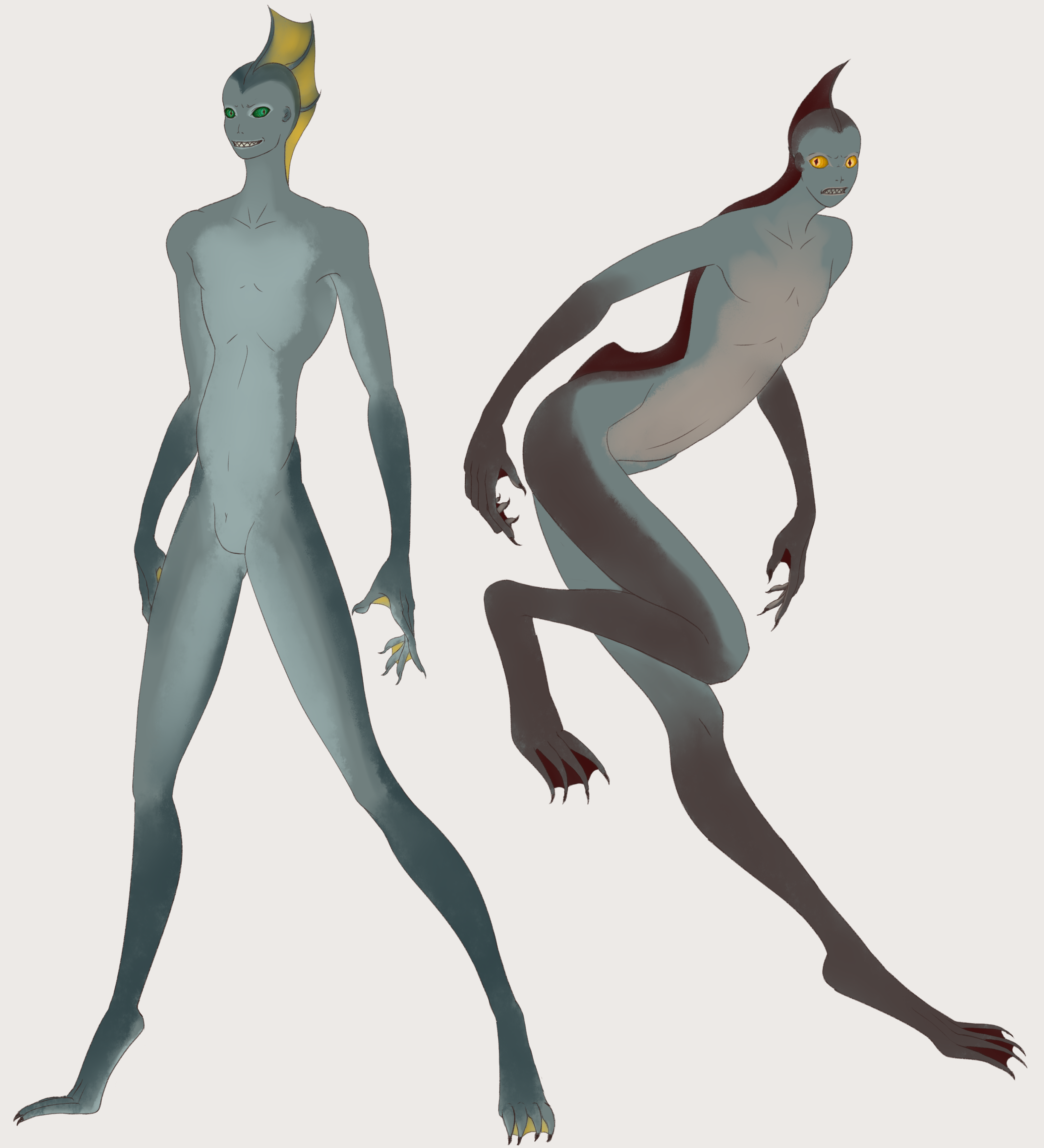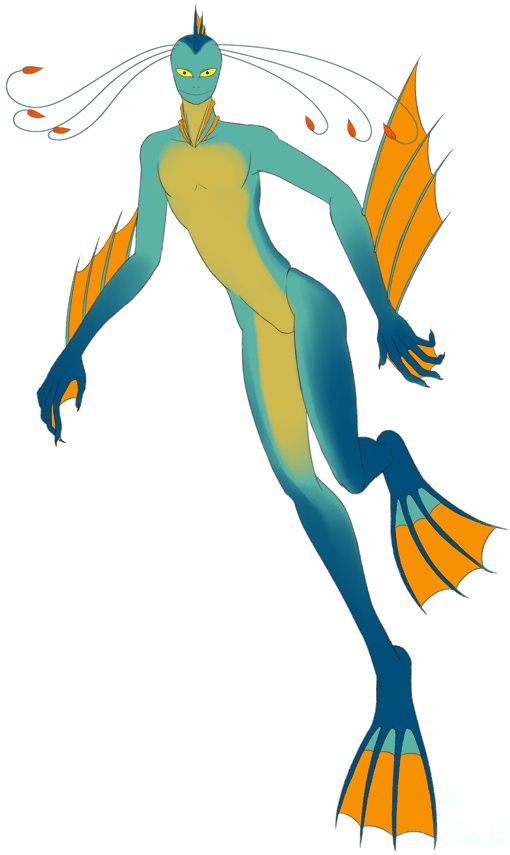Boromoem

Boromoem by Sehanbrel
Basic Information
Anatomy
Boromoem are a tall and skinny amphibious species, with webbed fingers and toes. Because of their violent nature, they also possess two pupils per eye, to be turned outward or inward depending on day and night cycles. They almost always end up getting one pupil damaged in their lifetimes, so nature's answer was to give them spares. They also have spongy, springy bones, so they're highly unlikely to break rather than bend. Thanks to their long legs, they're also exceptionally fast runners, and their webbed feet leave little behind in the way of tracks.
Most breeds are also poisonous, and while a breed may be immune to its own poison, they're not immune to another breed's.
They possess a four-chambered heart and bi-directional lungs. Swamp and rainforest breeds have rows of gills along the neck, with swamp breeds having a much lower profile, and rainforest having more colorful gills. Ocean breeds have gills down the neck and chest, and can flare out in a show of aggression.


Female Ocean Boromoem by Sehanbrel
Genetics and Reproduction
Rather than being tied to time of year or any predictable cycle, females only go into heat when resources are plentiful and the environment is safe enough. Once a male earns the right to mate with her, and the eggs are fertilized, it takes about 60 Vruanhaian days for them to develop enough to be laid.
If the population is thinning, or if resources are plentiful, a mother may choose to raise more than one child; especially if the father is kept around.
Regarding nests, it's common for those who have wandered their way into society and back to have small huts or tents, or caves built up to be warm and comfortable depending on the tastes of the individual. Others will use caves or burrows. When partnered, a nest is chosen based on who has the larger home, where the female will then proceed to build up a spot inside that's suitable for laying.
In the last two weeks of gestation, the female is rendered almost immobile, and must depend entirely on her partner for food and caretaking. In some cases, she will refuse to eat just to avoid having to get up.
Having highly elastic bodies, the labor of egg laying isn't particularly painful, but it is exhausting and uncomfortable. Anywhere from 50 to 150 can be laid at once, each about four inches in diameter.
Eggs that for sure did not get fertilized, or will result in an obviously handicapped child, are eaten. The egg(s) that did get chosen will be closely guarded, and carried in an egg sling against the mother's body at all times for the following four months of incubation. The egg will slowly double in size and develop a leathery exterior, thanks to a substance secreted by the mother's belly skin, which gets absorbed into the shell. It is not uncommon for the egg to fuse to her body from being held there for so long, which does eventually shed off.
The child is born almost fully developed; it is weak at first, cannot walk well, has overlarge fins, and must be kept moist at all times. They are however able to eat solid food.
Growth Rate & Stages
Incubation takes around four months, with childhood and adolescence roughly as long as a human's, and adulthood at twenty years.
Ecology and Habitats
- Swamplands
- Rainforest
- Ocean
Dietary Needs and Habits
Primarily consumes fish or any source of meat that's easy to obtain. They prefer to hunt soft things with internal skeletons. Land breeds can and will eat some plants, but given they only have sharp teeth, it's not very often; usually only when resources are scarce. Ocean-based breeds have flat molars for crushing up shellfish they catch.
Additional Information
Social Structure
They have a hierarchy based off of color and vibrancy, and also physical dominance, but beyond recognizing who is physically stronger, they have no real structure, being solitary creatures.
Facial characteristics
Round faces and pointy chins, with large, solid eyes with slit pupils. Mouth full of sharp teeth.
Perception and Sensory Capabilities
In addition to the basic senses, the fin on their heads is an extra sensory organ. When ducked underwater, the fin stays above the surface, able to detect variations in the air, temperature, and even scent, having tiny filaments in the center of the fin.
Civilization and Culture
Beauty Ideals
Nice, healthy coloration is preferred, and so is minimal scarring. While many scars can mean many won battles, it also implies they're not as good a fighter as one who has won just many fights with fewer scars. They also prefer smooth rather than angular faces.
Sometimes metal, bone, or glass-based jewelry is worn, but only ever as necklaces, bracelets, or waistbands.
Gender Ideals
In swamp and forest breeds, males should be clean-looking and colorful, with healthy fins and webbing, while females are preferred to be smaller than males and not outshine them color-wise.
However, in some areas where the structure is matriarchal instead of patriarchal, stronger-looking, larger females are preferred, with the males smaller and more vibrantly colored.
In ocean breeds, the more colorful a female, the better, and longer head tentacles are preferred. Males, again, should be smaller and stand out less visually.
Courtship Ideals
In all areas, males will compete over females, often maiming eachother in the process. It's not uncommon for one to kill to the other. The winner is rewarded with being permitted to mate with the female. Sometimes, the male must also best the female in a fight, if she's feeling like the male isn't as strong as she is.
Relationship Ideals
Once mated, the couple remains together until their chosen egg of the clutch hatches, and through some of their offspring's childhood. During this time, they control a territory together, one that's larger than either of them would have while alone. They will fight to protect eachother and their offspring, and it is possible for the pair to become friends.
After the child is old enough, the pair usually parts ways, but might meet again next mating season.
Major Language Groups and Dialects
Grenil
- Ketilts dialect
- Lacht dialect
- Syr dialect
- Aul dialect
- Ocean dialect
Culture and Cultural Heritage
The boromoem are largely aggressive, territorial, and downright cruel. While there are some exceptions, their inherent traits makes avoidance of swamps generally a very good idea for anyone traveling. Known to be mostly carnivorous with some omnivorous traits, they hunt somewhat indiscriminately and will eat anything that has meat on it, barring creatures known to be toxic.
They will hunt for food as well as for sport, but given their survival instinct is so much stronger than that of other species, they tend to stay away from creatures that would put up too much of a fight and risk greatly injuring themselves. If they don't outright try to kill a foreign trespasser, they will harry them throughout their journey, sometimes by attempting to steal from them, or setting traps in their way to injure - anything to show that the boromoem is the dominant presence.
Territorial to a great extent, they are usually seen alone, if at all. Despite their natural inclination towards violence and solitude, friendships are not rare, though they do have an emphasis on respect of personal space. It's also not uncommon for a male and female pair, once mated, to mate for life if they get along well.
Common Customs, Traditions and Rituals
Tattooing is common, done to show what rites of passage one has gone through. Some have spiritual meaning. Decorative scarification is used in the same way, and both are initially done by the mother to the child as they grow, and the child learns how to do it themselves from the mother when they're older. Land-based boromoem tend towards scarring, while ocean-based will tattoo instead.
Common rites of passage are reaching adulthood, a boromoem's first big kill, and first mating.
Common Myths and Legends
When the world was younger, there was a hateful, angry foga, who lived all alone in a swamp. One day, a kenanik wandered into his lair, and the foga, uncaring why he had an uninvited guest, ate the kenanik without a second thought.
An ysai, angered that his vassal was killed, said to the foga, "I will make you suffer as people do, since you have no respect for other creatures." And then, he turned the foga into a man, but one with sharp teeth and amphibious features, so all would know his crime.
It is from him that the boromoem came to be.
Interspecies Relations and Assumptions
They don't care about other people, or eachother, beyond food and potential mates. They wish to be left alone to do as they please.
Lifespan
800 years, though they usually die in battle before they reach 100.
Average Height
6'0"-7'5"
Average Weight
160lbs - 260lbs
Average Physique
Thin and wiry, with the occasional thicker, muscled variant.
Body Tint, Colouring and Marking
Swamp and rainforest breed males are more saturated hues of greens, teals, reds, yellows, and browns, while females are more desaturated. Usually 2- or 3-toned, with an underbelly color, a middle shade, and a back color.
Ocean breed is inverted, with the females being more vibrant and brightly colored, and the males being plainer and smaller.


